Moez Street in Cairo: An Ultimate Local’s Guide
9 min readHere are the best things to do on Moez Street in historic Cairo – a must-visit on your Egypt itinerary.
Must-see highlights:
1. Bab Zuweila
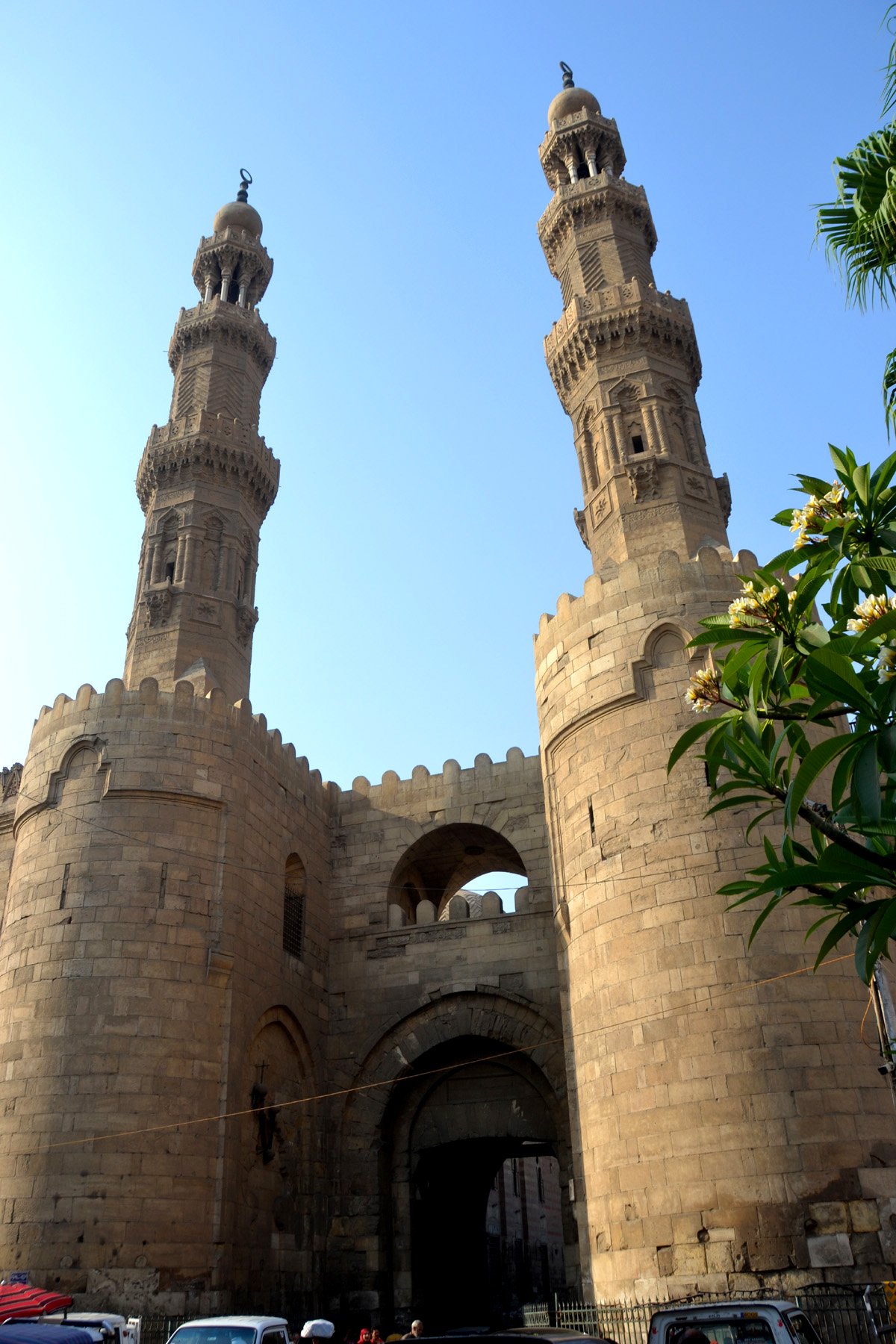
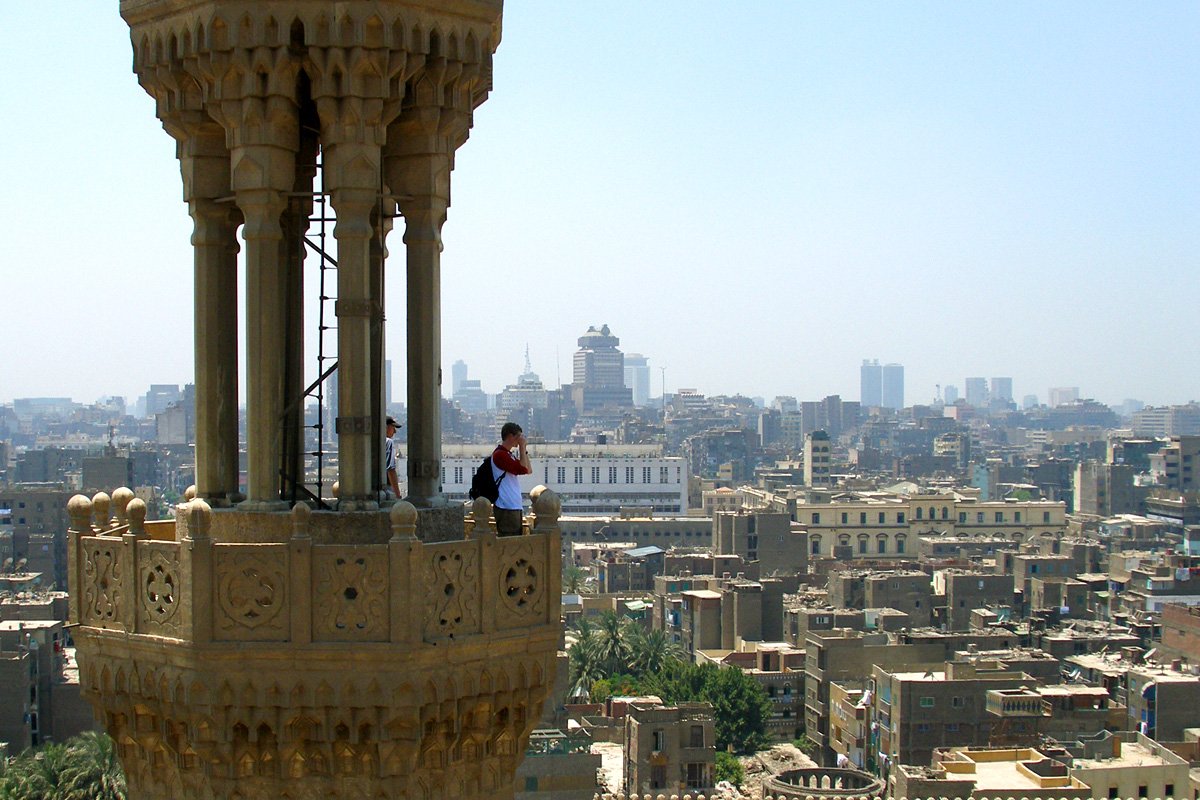
Vyacheslav Argenberg, CC BY 4.0, via Wikimedia Commons
Bab Zuweila is one of the few remaining gates of the city wall that encircled 11th-century Cairo. It’s topped by two minarets that were added on by a Mamluk sultan in the 15th century.
And you can climb to the top for some great views of the old city.
The steep stairs are quite a workout. But it’s worth it for the sweeping views of Fatimid Cairo and the surrounding minarets. It’s especially magical during the call to prayer.
Historical facts:
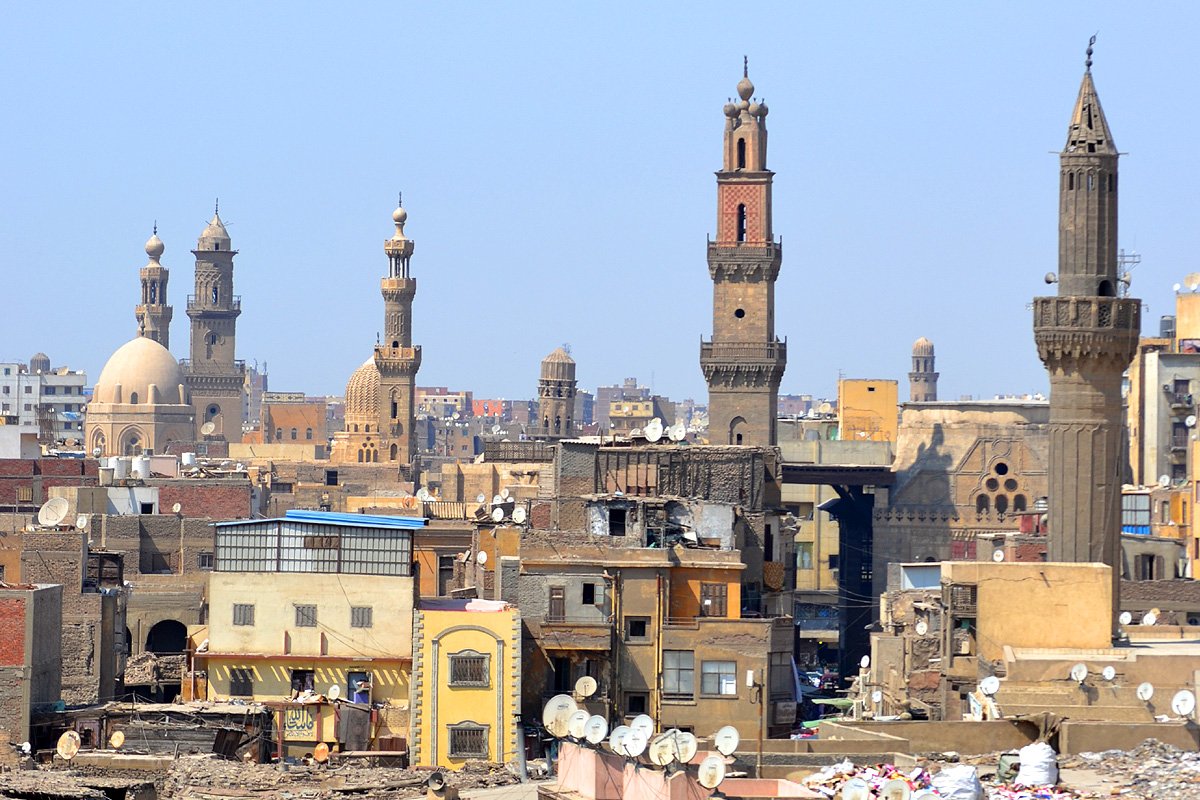
- The towers of Bab Zuweila were once used to scope out approaching enemy troops.
- The sultan also used the platform to watch Mecca-bound processions headed on the annual pilgrimage.
- The gate also has a grisly history: the platform was used for executions. And severed heads were displayed on the tops of the walls as recently as 1811 after the Citadel massacre of the Mamluks by the Ottomans.
Insider’s tip: If you’re visiting the nearby Mosque of Sultan Hassan and Khan el Khalili is next on your itinerary, then take a tuk-tuk from there to Bab Zuweila – it’s quite a trip but definitely doable.
Need to know:
Tickets: 40 EGP per adult, 20 EGP for students with valid ID.
On Google Maps: 27V5+34J
2. Khayamiya market
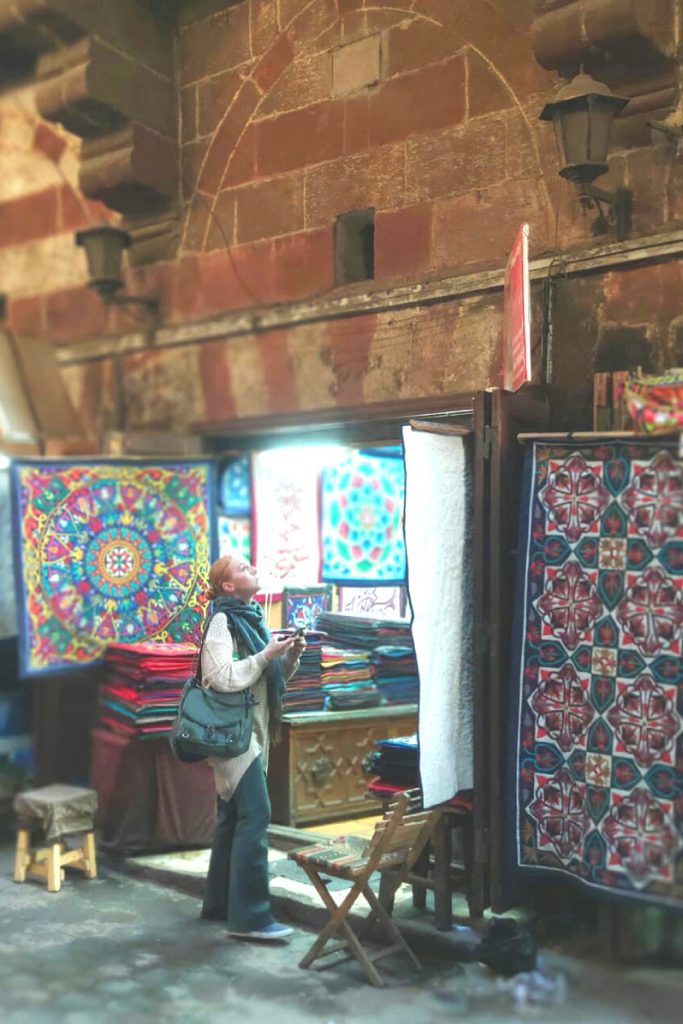
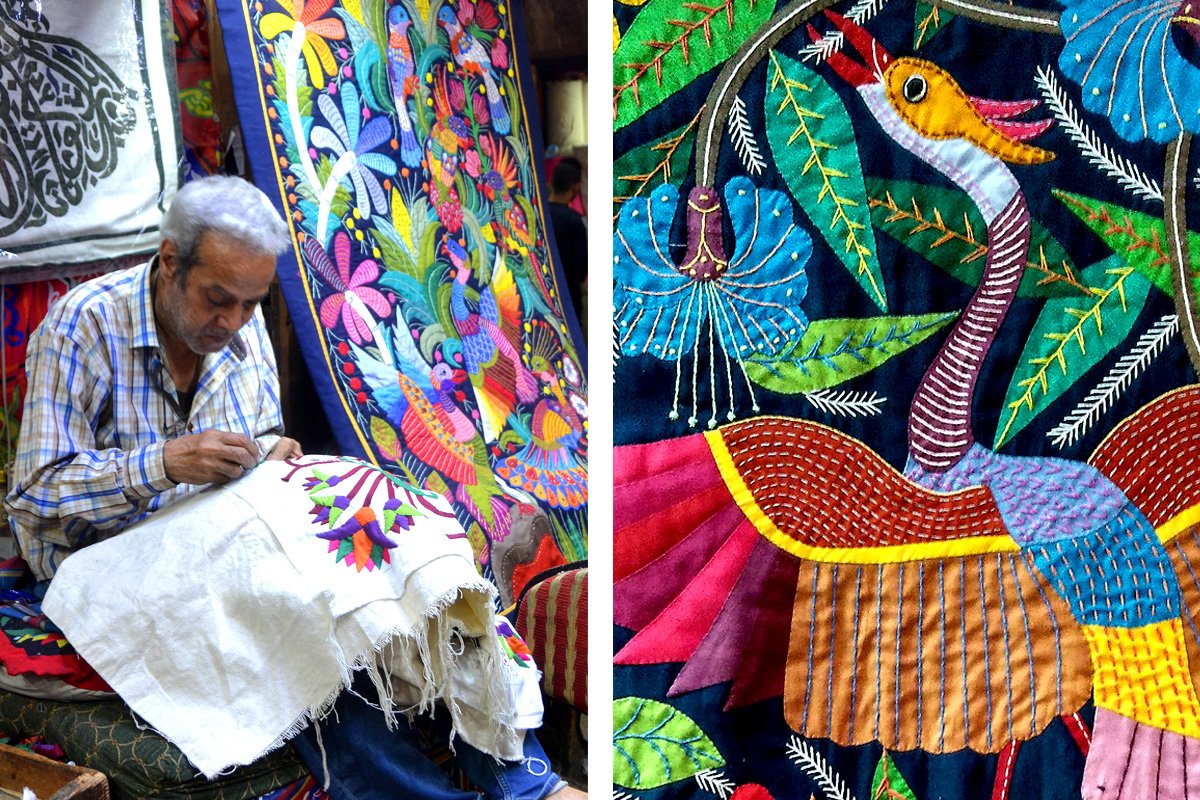
Known as the street of the tentmakers (Sharia al-Khayamiya), this covered market sells a colorful type of decorative applique textile known as khayamiya.
It’s also one of my favorite places to shop in medieval Cairo – it’s far less crowded and the vendors aren’t as pushy as their Khan el Khalili counterparts. They’ll generally give you a fair price from the start and there’s not much need to haggle.
There are rugs, quilted pillow cases and wall hangings sold by the artisans themselves in their tight and narrow shops.
And you’ll often see the artisans at work hand-stitching cushion covers or bedspreads. Their needles tackle themes from Islamic calligraphy to Ancient Egypt, local folklore, fish, birds and verses from the Quran.
When I was last there, quilted pillow cases sold for about 75 EGP each. I could have probably got them for a dollar less. But the money goes directly to the artisan so it’s worth paying fairly.
Historical facts:
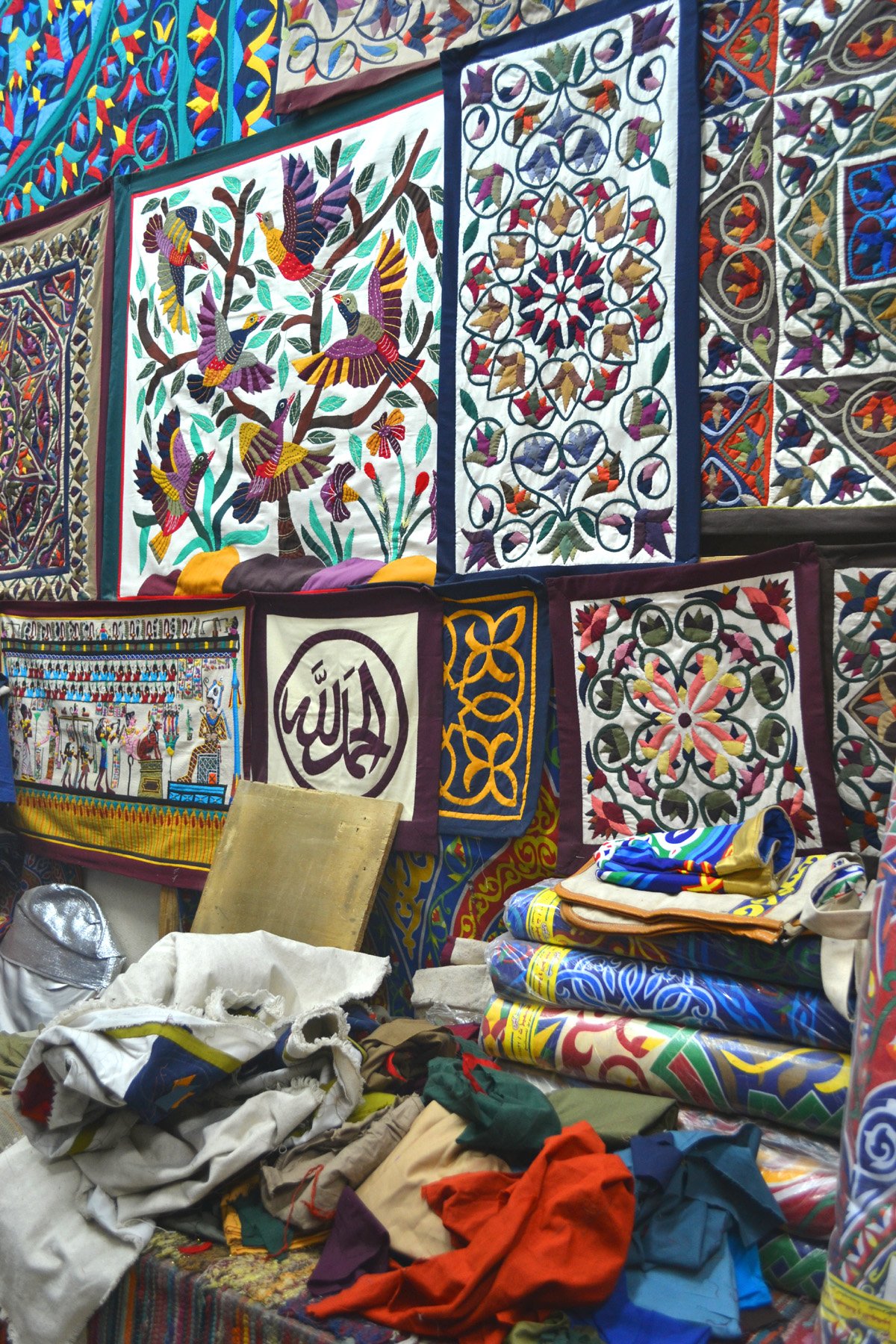
- The Qasaba that houses the khayamiya market is worth a look in itself. Built during Mamluk rule in 1650, it’s the only historic covered market in the city. Look above the shop facades and you’ll see the upper floor apartments built for the artisans.
- There’s evidence that khayamiya dates back to Ancient Egypt. But this traditional craft is now endangered because of cheap imitations and factory-printed fabric.
Need to know:
Hours: Open from around 9 am until late in the evening.
On Google Maps: 27R4+FXF
3. El Fishawi Cafe
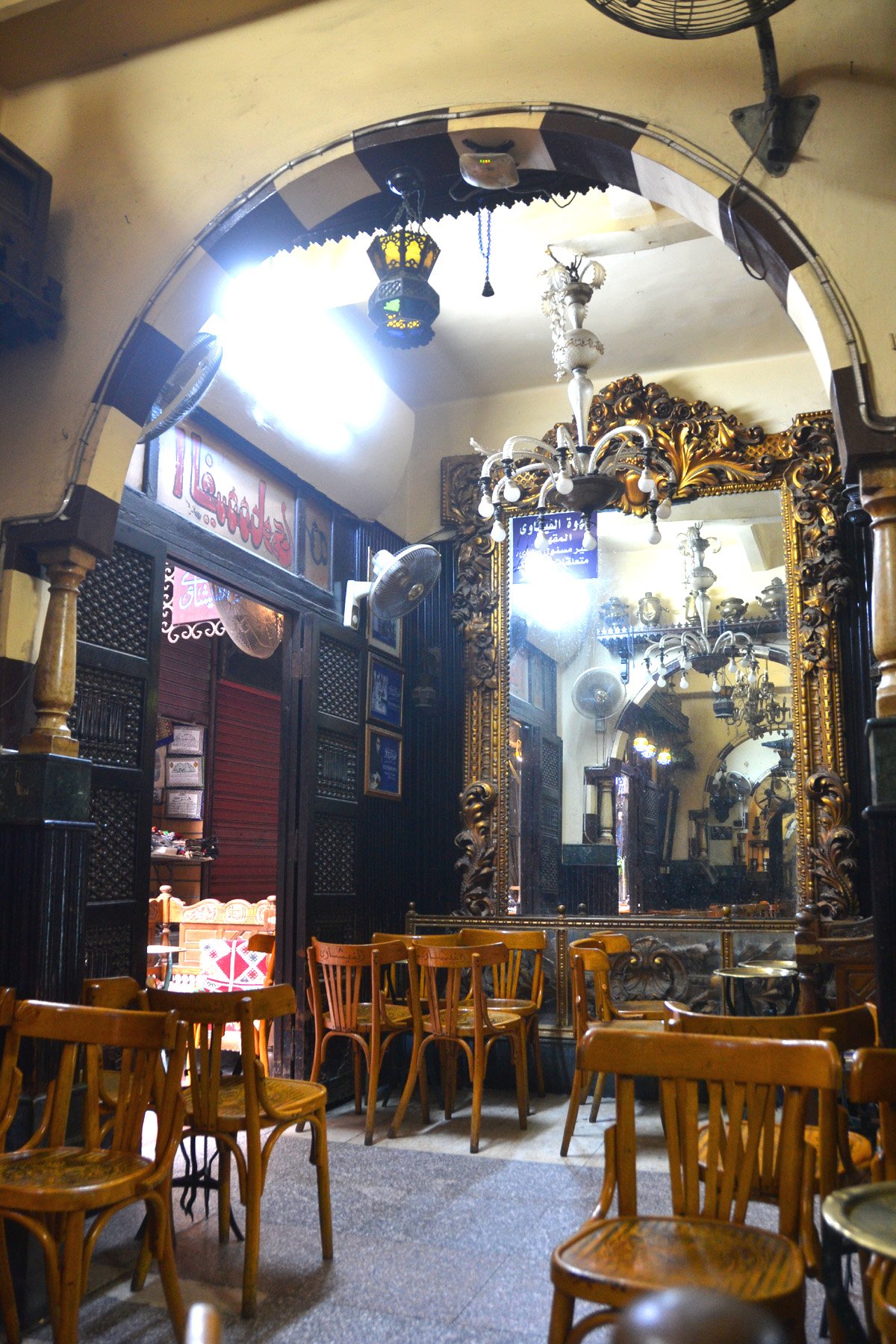
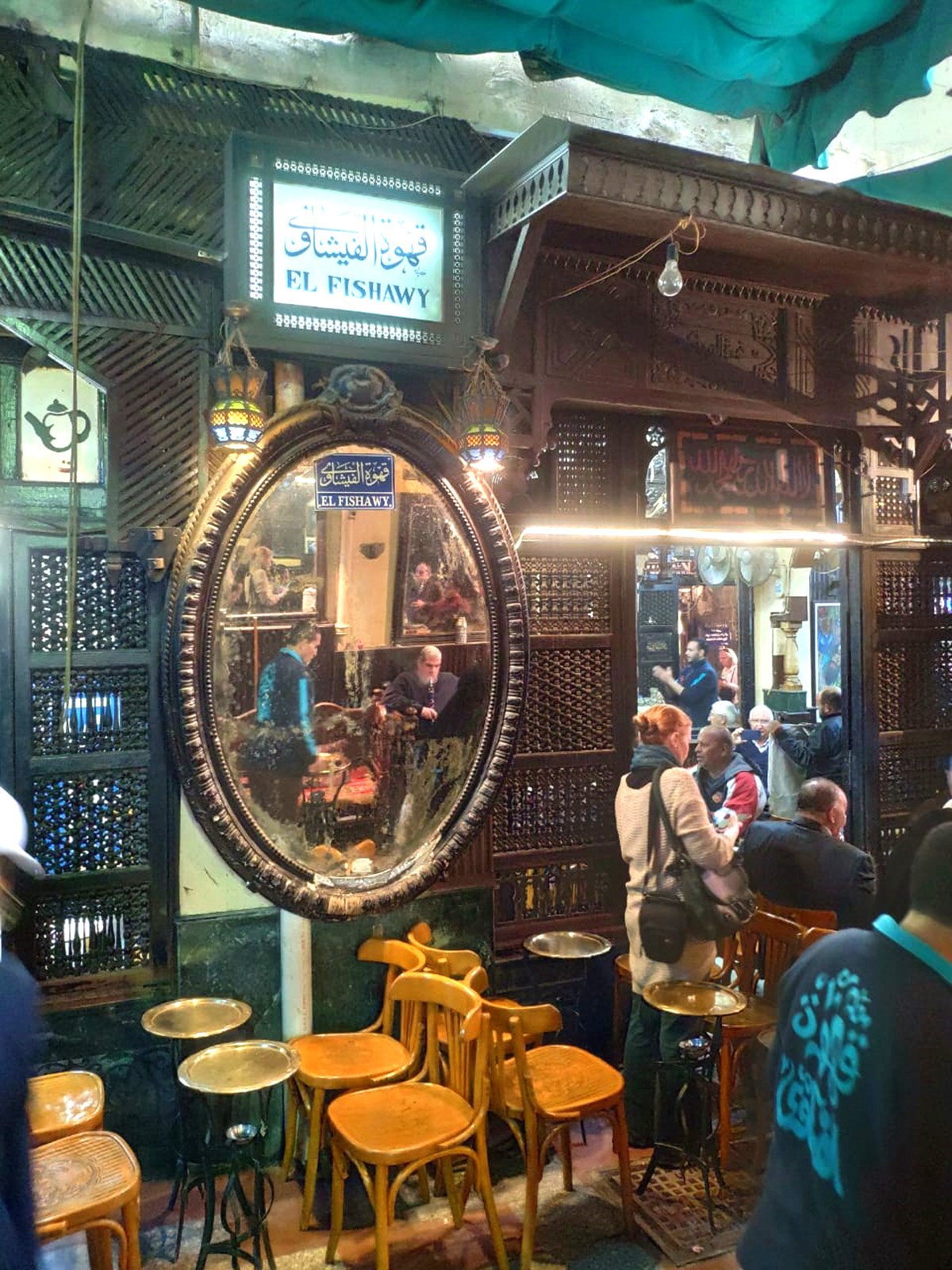
Tucked inside a narrow alleyway, El Fishawi is one of Cairo’s oldest cafes.
Dating back to 1771, this Cairo icon is packed with mashrabia, chandeliers, enormous mirrors and lots of historic charm. Sip on some mint tea, listen to live oud music, puff on a shisha and take in the lively atmosphere of Historic Cairo.
But be prepared: this isn’t exactly the place for quiet conversation. You’ll be interrupted by a constant stream of street vendors trying to sell you prayer beads, necklaces and other trinkets. And you’ll be charged tourist prices for tea and coffee – without an official menu in sight.
But El Fishawi is worth a stop to experience that old Cairo coffeehouse atmosphere. It boasts a rich history as the watering hole for two centuries of Egyptian intellectuals, artists and writers. Illustrious guests include King Farouk and Nobel-Prize winner Naguib Mahfouz, wrote parts of his Cairo trilogy in the cafe’s back room.
Recommended: Try the traditional Egyptian mint tea, served in battered enamel teapots with sprigs of mint on the side. In winter, try some sahlab – a hot, creamy wheat drink topped with nuts and raisins.
On Google Maps: 27X6+2X (though once you get close, it’s best to ask the locals for directions)
4. Sultan Al-Ghuri Complex
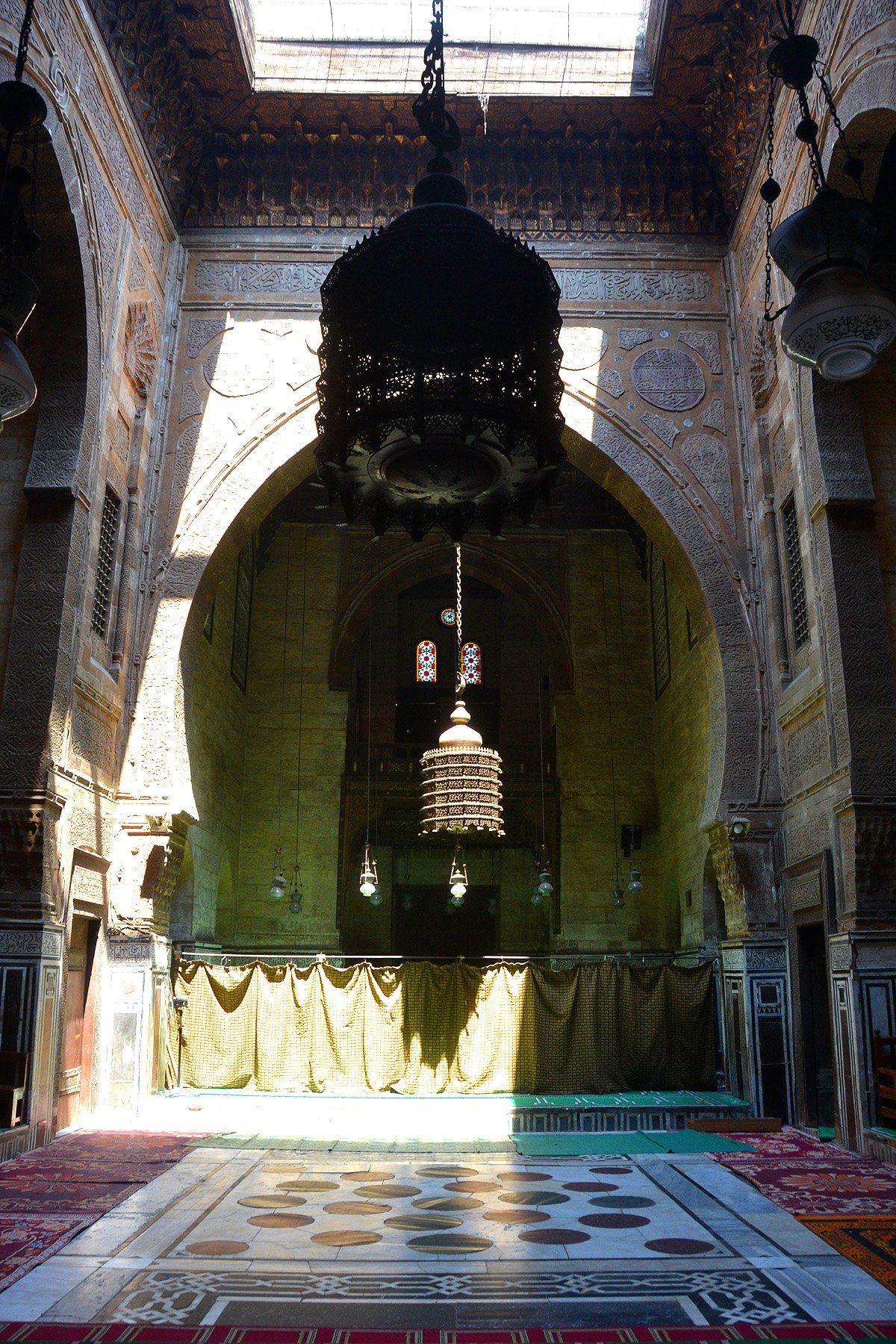
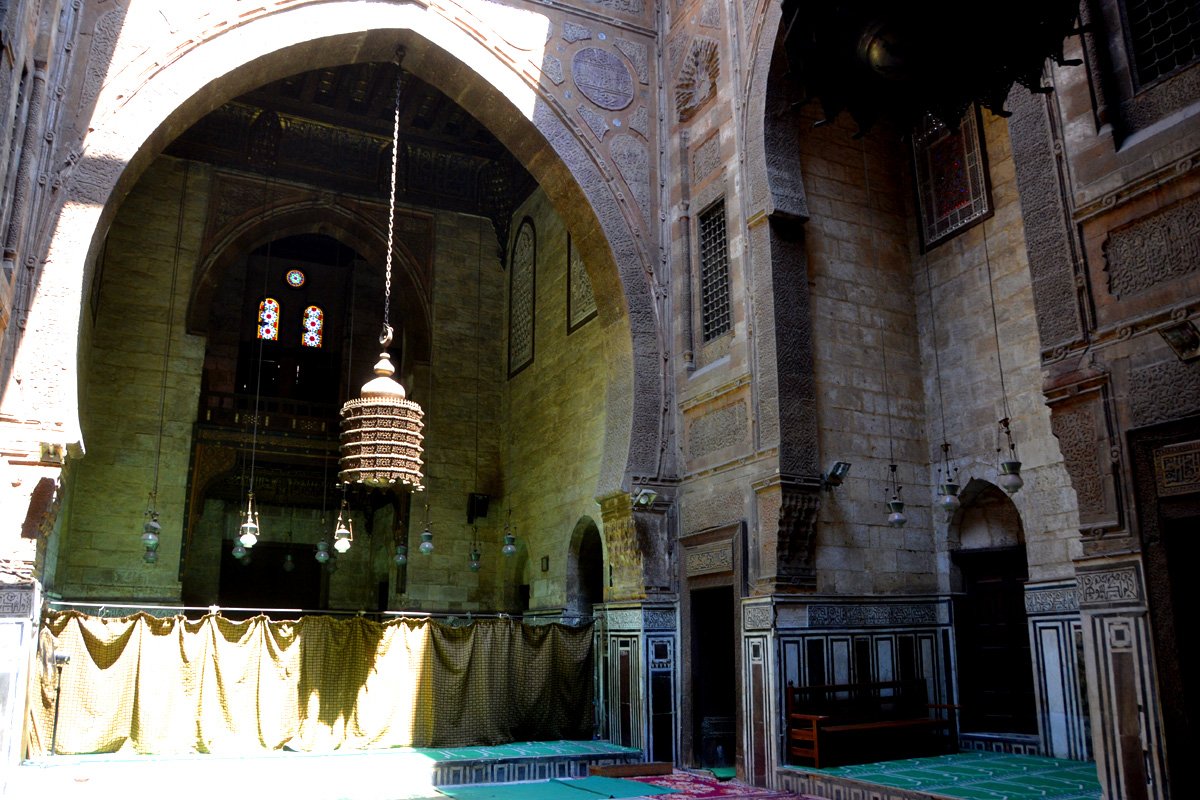
The majestic Sultan Al-Ghuri Complex, an ornate Mamluk gem completed in 1505, includes a mausoleum, mosque and madrasa.
It’s on a bustling street that once housed a silk market. Today the pathway is packed with vendors selling rolls of fabric, seasonal fruit and kitchen knick-knacks.
And it’s just across the street from the famous Khan el Khalili market.
The interior is overflowing with the lavish patters typical of Mamluk style. There are soaring ceilings and geometric lamps suspended from long chains. Rich panels repeat patterns of black and white marble.
And while it’s not a massive mosque, it’s a true delight to explore.
Outside you can see its unique square minaret topped by five bulbs.
Al-Ghuri, the second last of the Mamluk sultans, was described as cruel and superstitious. But he had a soft spot for music and poetry. He was a great patron of architecture despite the miserable economy of his age. And though Al-Ghuri died in battle, he was never buried in the mausoleum he erected.
Need to know:
Tickets: Free.
On Google Maps: 27W5+FV
5. Al-Azhar Mosque
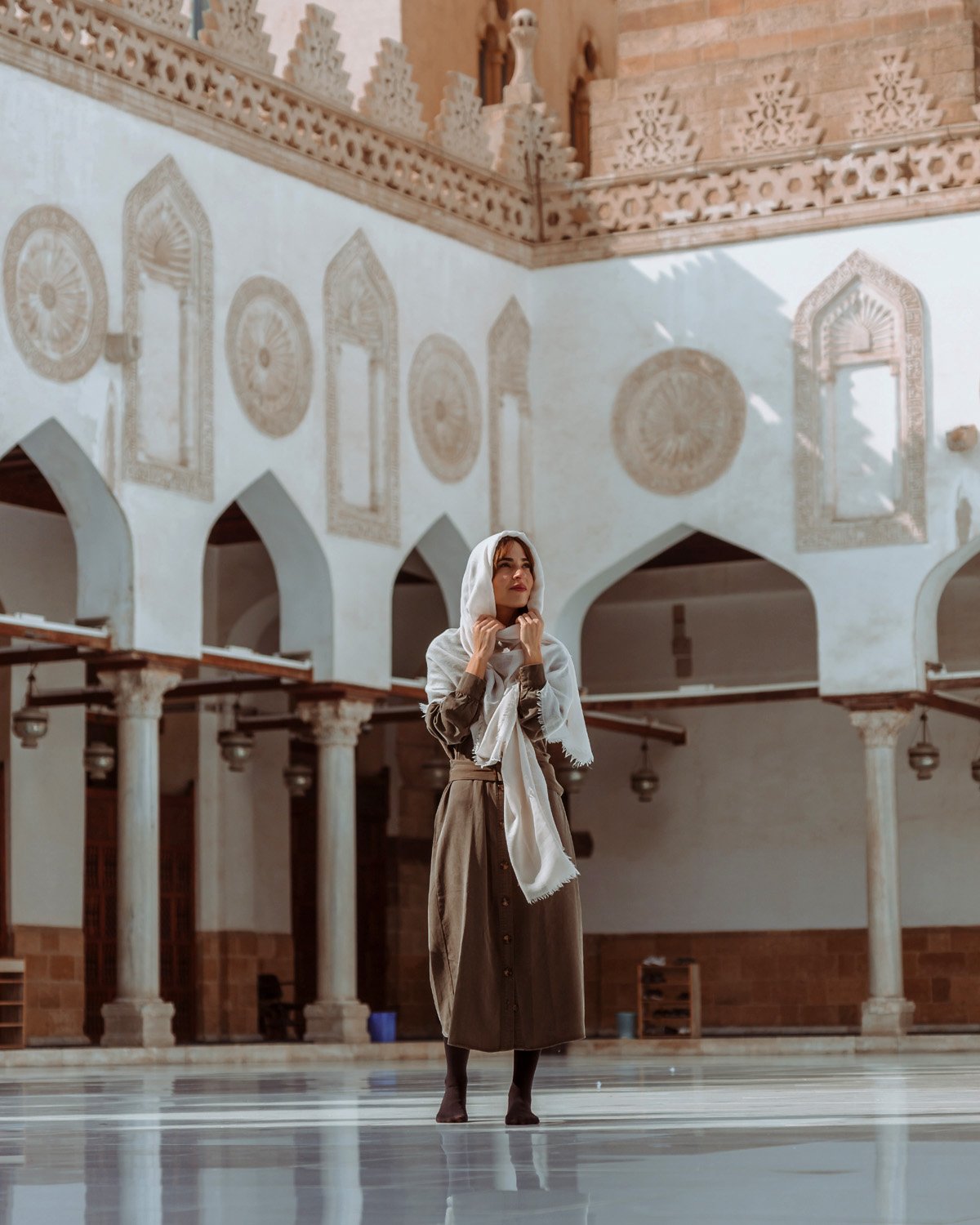
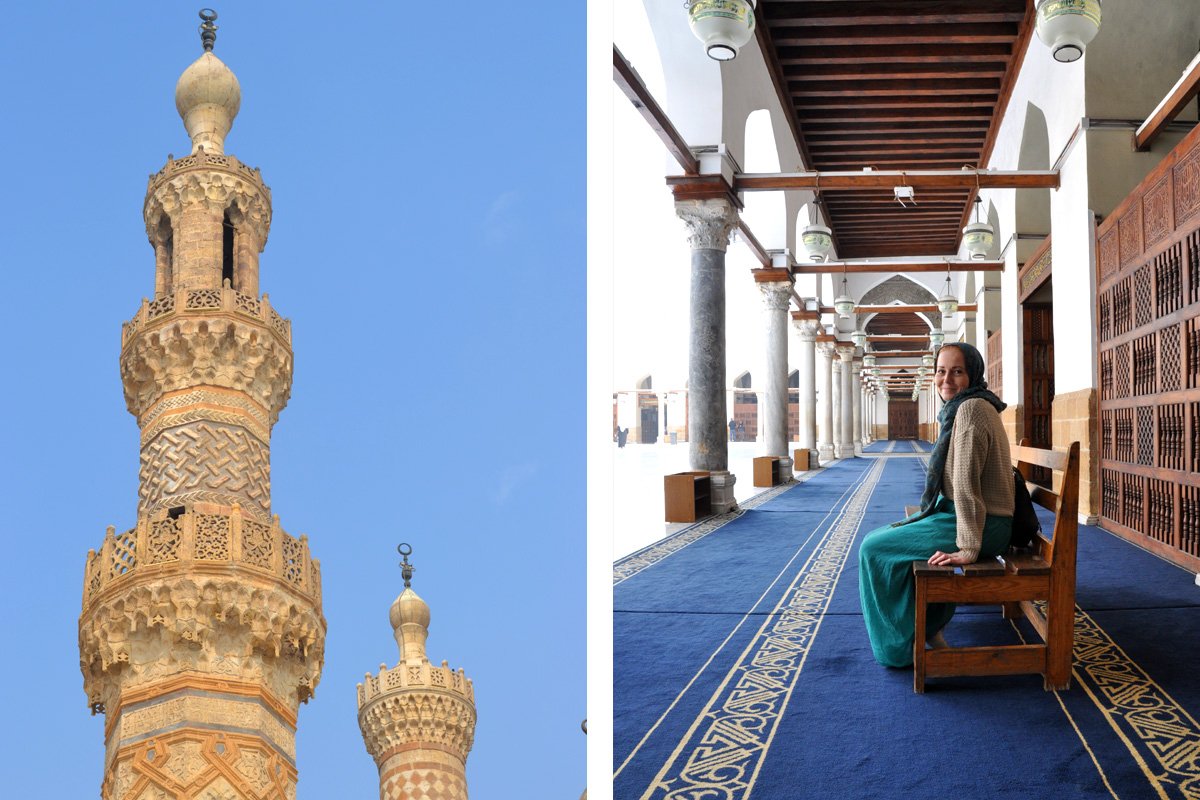
Al-Azhar Mosque is a recently restored masterpiece – and an easy drop-off point for any Uber that also makes a good starting point for a Khan el Khalili tour.
Established in 972, Azhar Mosque is the highest authority in the Islamic world for the study of Sunni theology. And it attracts students from around the world – you’ll probably see Southeast Asian students around its walls.
The courtyard at Azhar Mosque is paved in white marble and surrounded by Mamluk-era minarets.
If you’ve never been inside a mosque, this is a breathtaking introduction with its bright masonry, wooden ceilings, mashrabiya windows and ornaments. It includes five intricate minarets – remnants of the city’s various dynasties and their influence.
Historical facts:
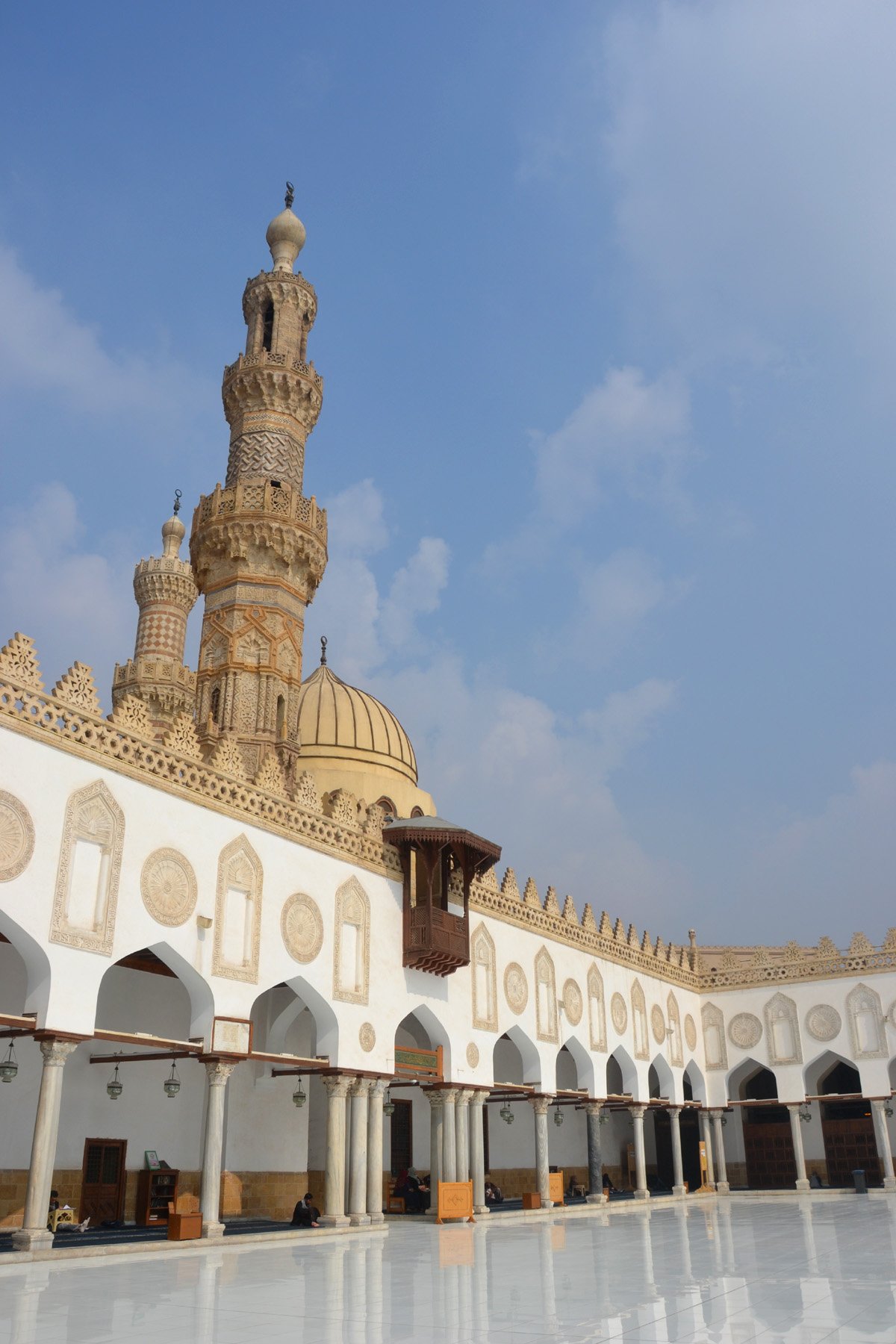
- Built under a Fatimid caliph, Al-Azhar Mosque was the first Fatimid monument in a newly established capital.
- Today, it’s around double its original size with a capacity of 20,000 people.
- It’s also the home to Al-Azhar University – the prestigious center of Sunni theology and the world’s second oldest continuously-run university.
A visit to Al-Azhar Mosque is always a calming experience. The honking cars and vendors of the nearby market are silenced, and the breeze winds around the mosque’s rows of columns. It’s a real treat on a hot summer day.
Insider’s tip: If you’re a woman wearing jeans or tight pants, you’ll probably be issued a long skirt at the entrance to cover up. Those can be awkward to walk in, so consider wearing a long skirt if you’re headed to Islamic Cairo and plan to visit lots of mosques.
Need to know:
Tickets: Free.
On Google Maps: 27W7+73
6. Abd El-Zaher Bookshop
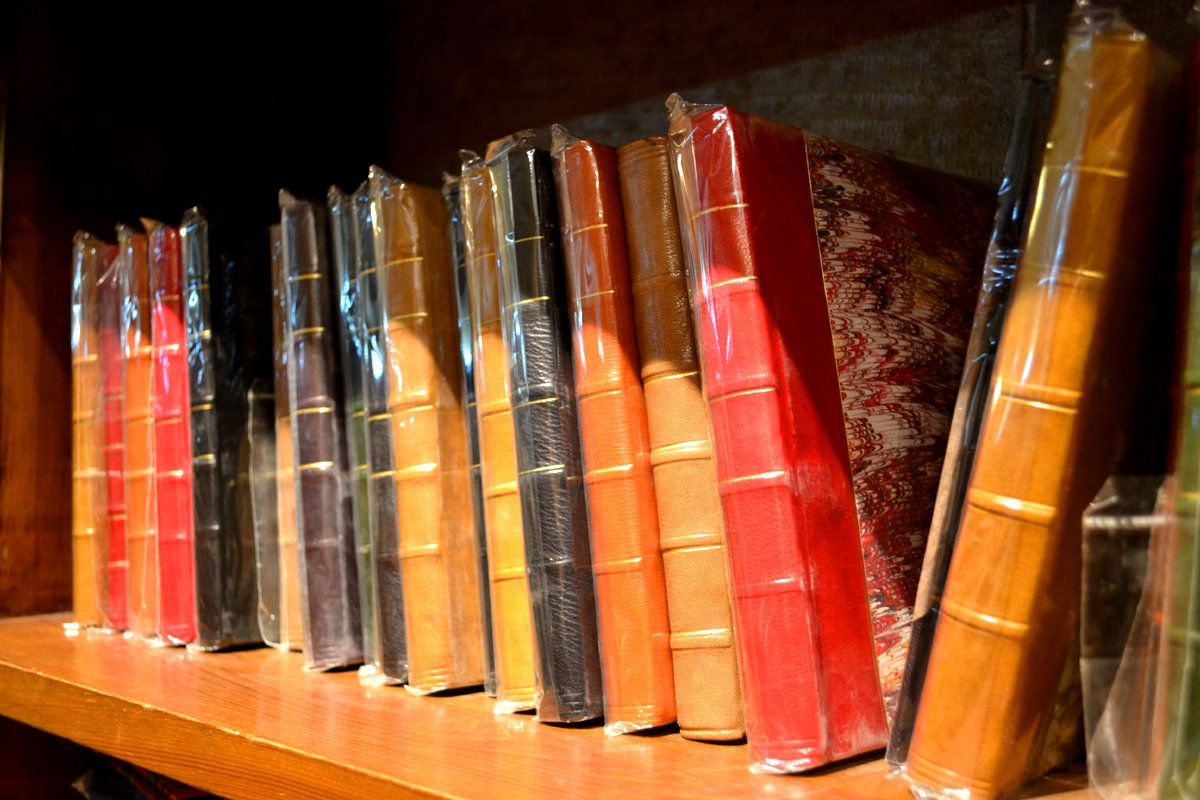
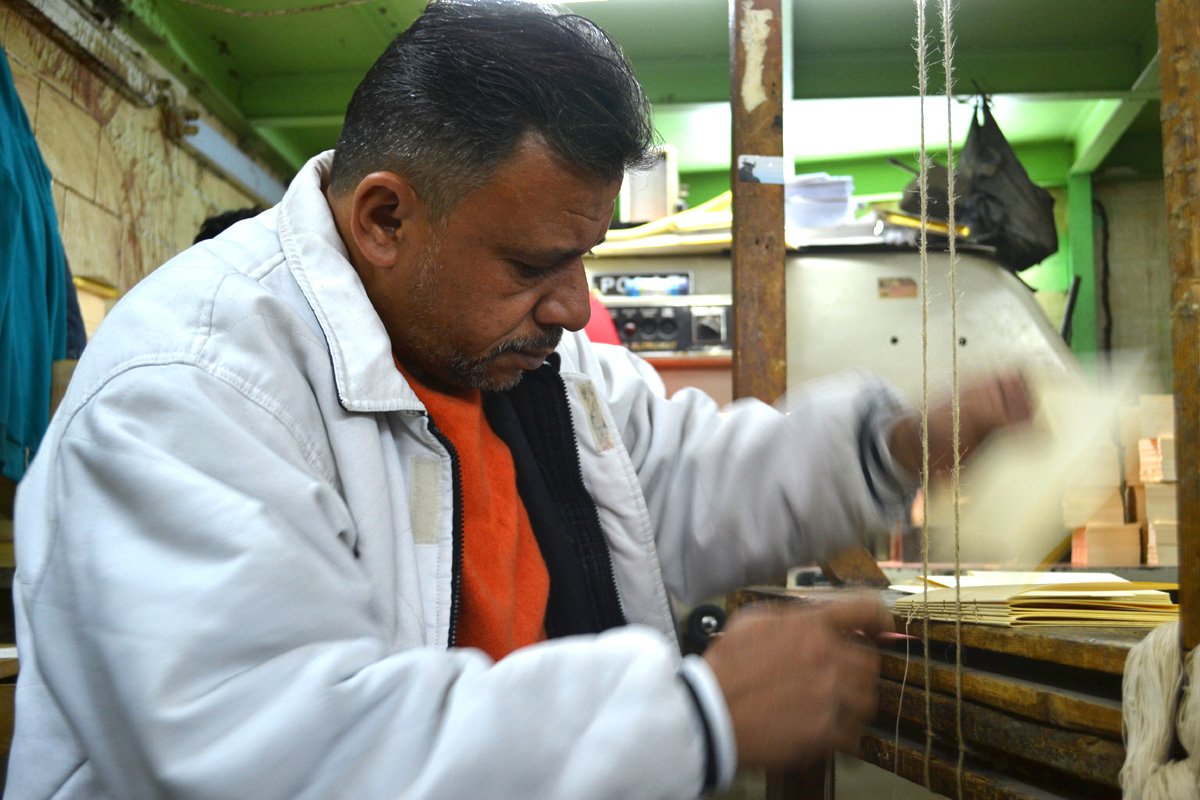
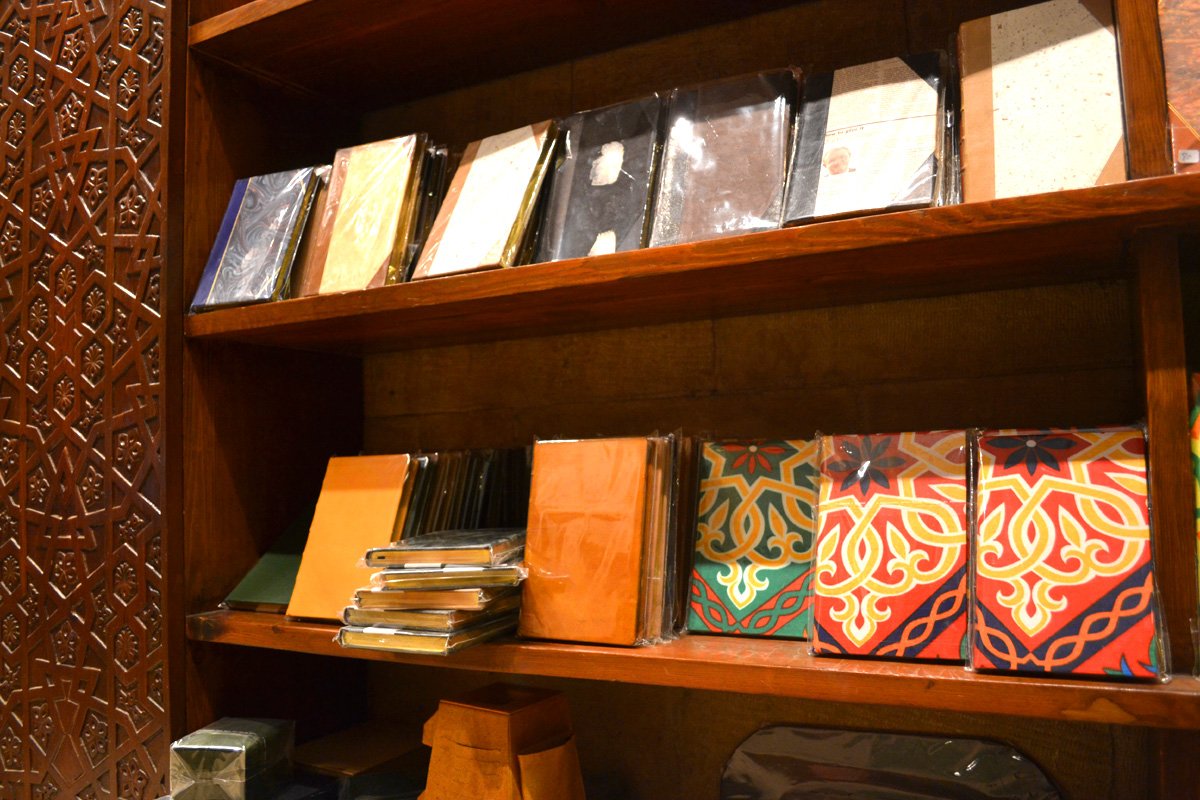
Abd El-Zaher offers personalized leather-bound notebooks, bargain-priced notepads, photo albums with old-fashioned mounting corners, sketchbooks, vintage postcards and a small selection of books.
This beautiful gem of a bookshop is tucked away on a sidestreet behind Al Azhar Mosque.
The workers can stamp your name (in Arabic or English) into any notebook you choose – on the spot while you wait. You can watch the craftsmen at work on the lettering too.
If you have old books that are falling apart, Abd El-Zaher can rebind them for you. Though rebinding means leaving your book there for approximately 10 days.
The Abd El-Zaher Bookstore is more than 80 years old and is home to three generations of craftsmen keeping the rare art of book binding alive.
Shopping at this small and cozy boutique is an experience. And what better way to record your Egyptian vacation than in a personalized travel journal?
On Google Maps: 27W6+5X El-Darb El-Ahmar
7. Qalawun Complex
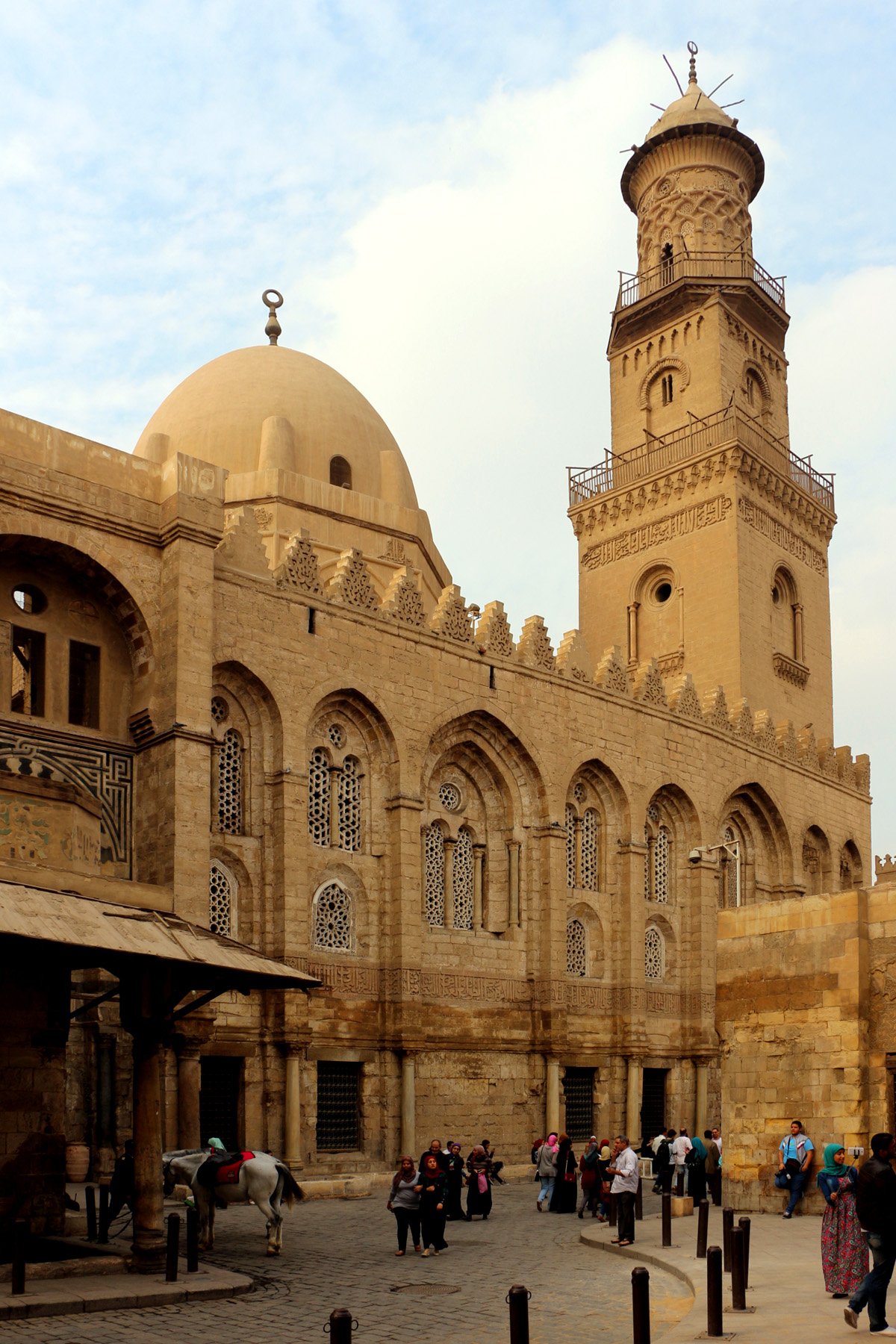
Photo: Sailko, CC BY 3.0, via Wikimedia Commons
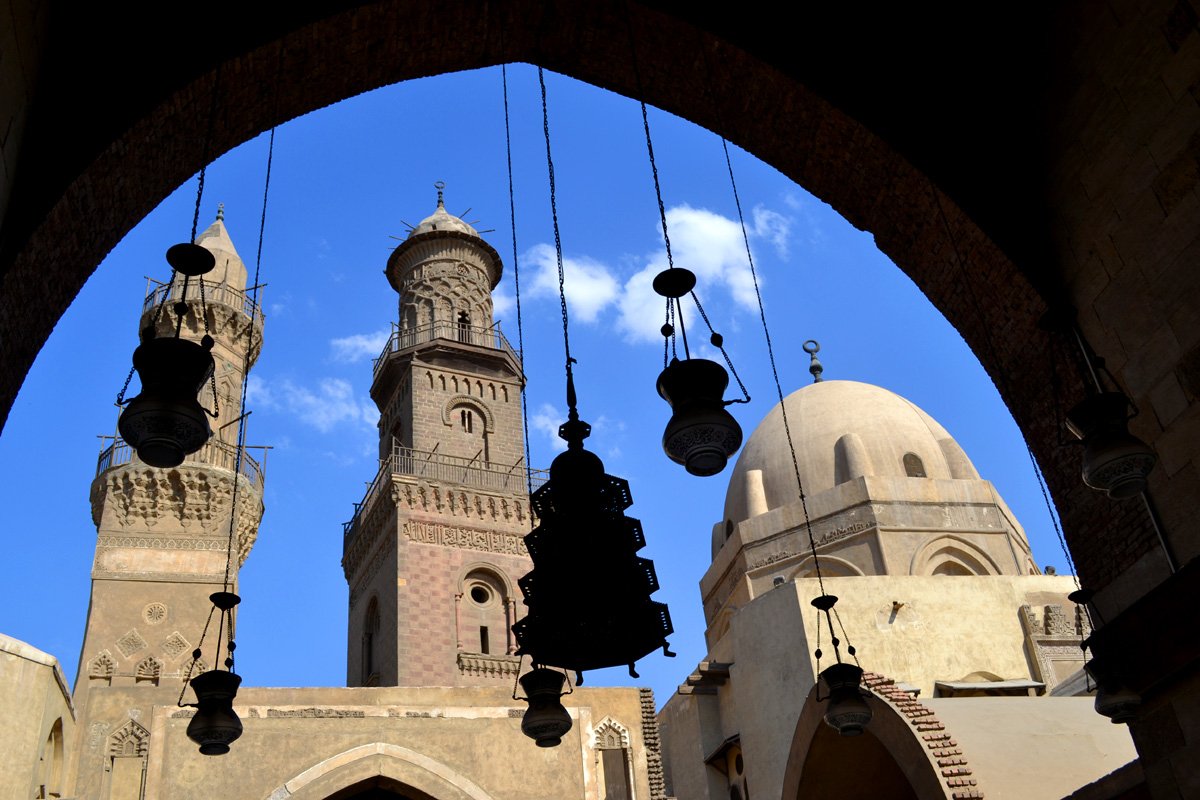
The Qalawun Complex is one of the major monuments of Islamic Cairo – and one of the gems along the famous Moez Street in Khan el Khalili.
This massive complex was built by a Mamluk sultan in the 13th century. And it’s incredibly rich in its scope and architecture.
It contains a hospital, madrasa and a mausoleum considered to be one of the most stunning in the world – and second only to the Taj Mahal.
But miraculously the complex only took about a year to build, thanks to the sultan’s disciplined leagues of slave labor.
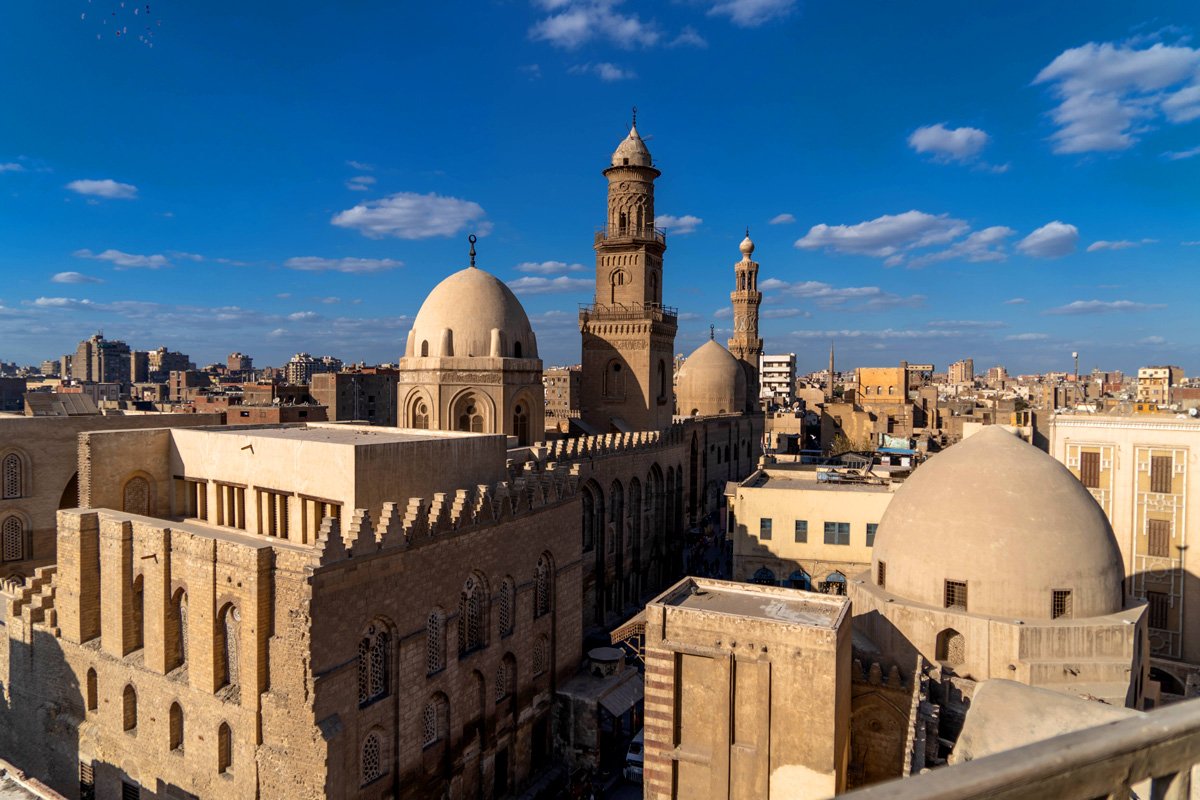
The mausoleum’s mihrab (a niche in the wall pointing to Mecca) is considered the most splendid of its kind. Flanked by three marble columns, it’s embellished with ornate geometric patterns.
You can easily spend an hour or two exploring this vast complex and savoring the intricacies of Mamluk architecture. It’s definitely the highlight of any Medieval Cairo itinerary.
Need to know:
Tickets: Entry is 100 EGP per adult. The ticket gives you access to the Qalawun Complex and a slew of other attractions including the nearby Qalawun Mosque, the Barqouk Mosque and the Amir Beshtak Palace.
On Google Maps: 27X6+Q94
8. Aqmar Mosque
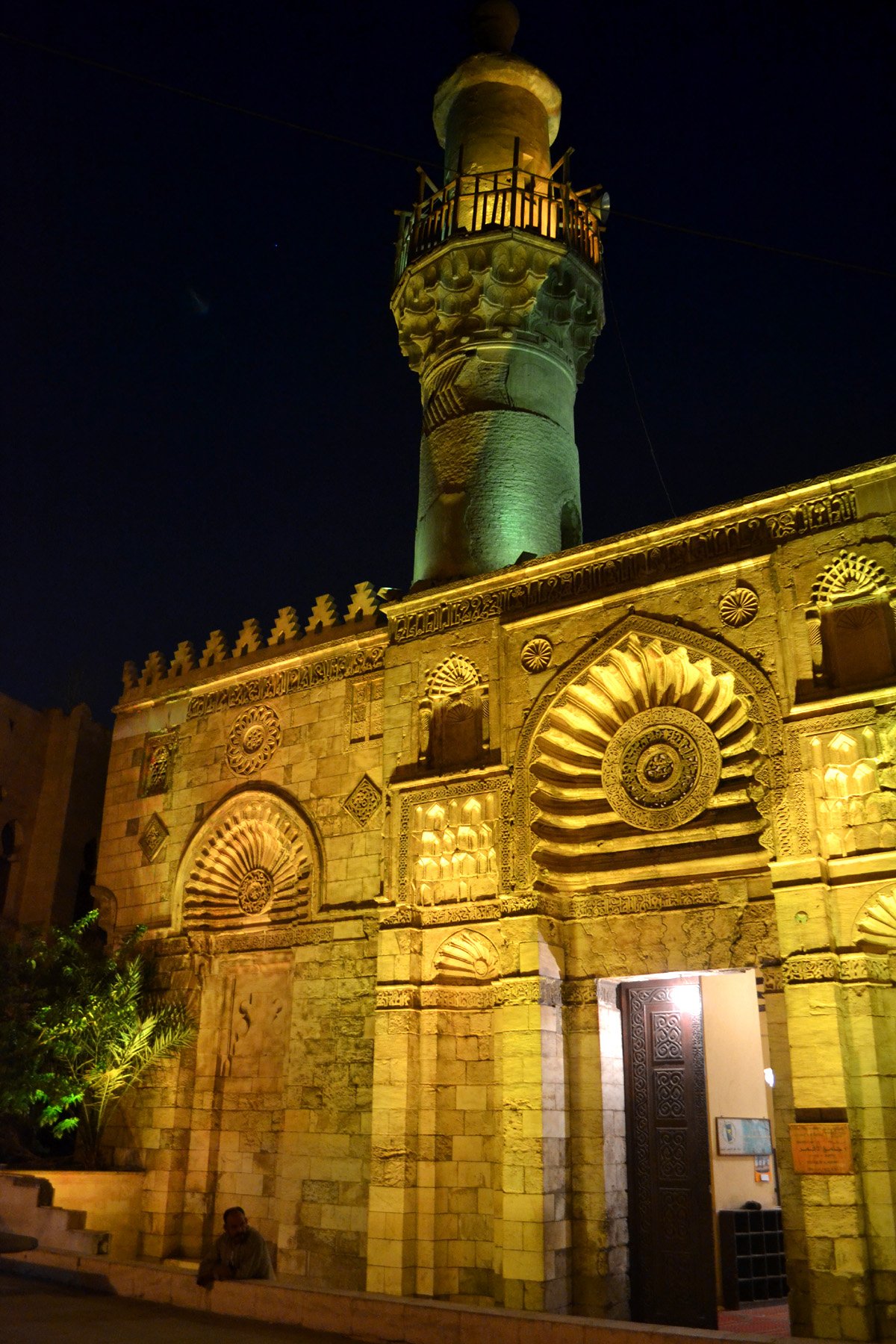
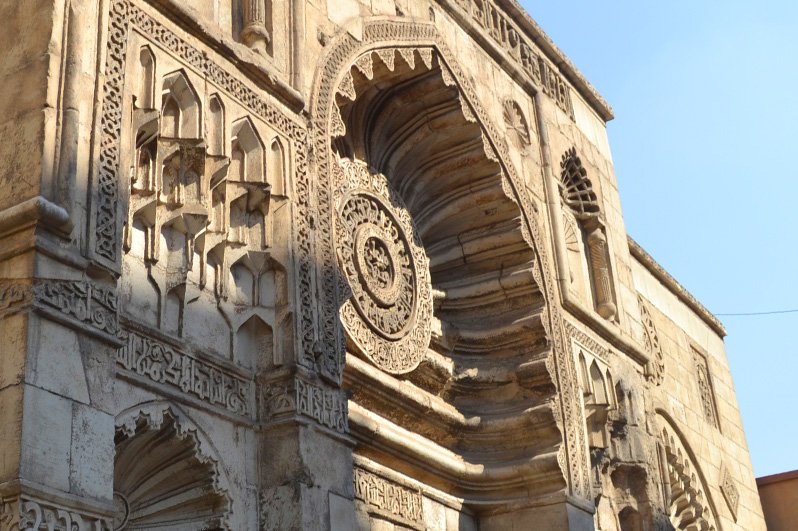
Aqmar Mosque is tiny by Moez Street standards. But it has a stunning facade that looks especially magical illuminated at night.
Aqmar Mosque catches your eye as you stroll down Moez Street. It’s very well-known for its intricate facade.
Historical facts:
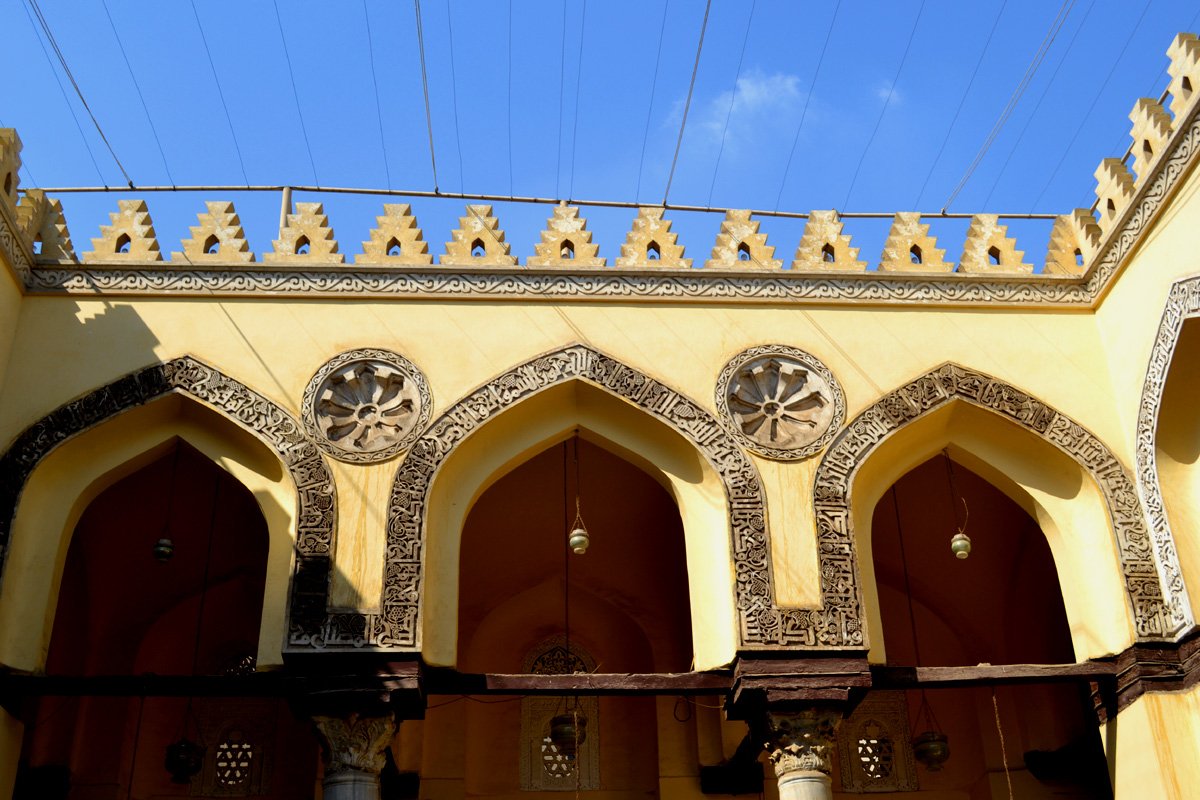
- Appropriately named the “moonlit” mosque, it was built in 1126 by a Fatimid vizier.
- It served as the neighborhood mosque for local residents and the inhabitants of the nearby Fatimid Great Palace.
- It didn’t originally feature a minaret – probably to prevent people from climbing up to get views of the caliph’s palaces. A Mamluk amir later added a minaret.
Spend some time marveling at the facade’s lavish decorations including intricate niches, shell shaped recesses, Quranic inscriptions, abstract symbols and radiating stars.
And step inside the beautiful and airy courtyard, uniquely restored in a yellow pastel.
Need to know:
Tickets: Free.
On Google Maps: 3726+JQF
9. Bayt al-Suhaymi
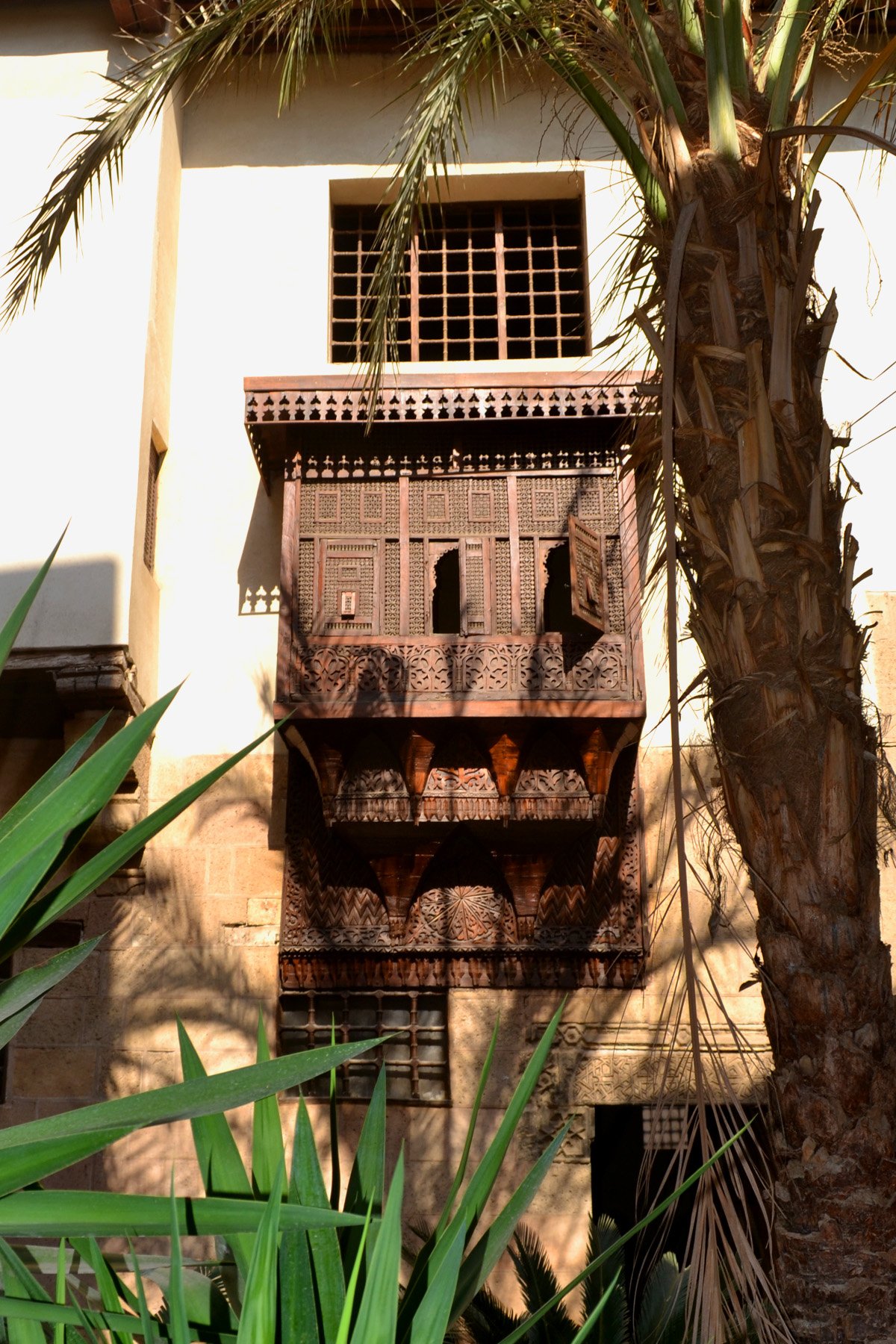
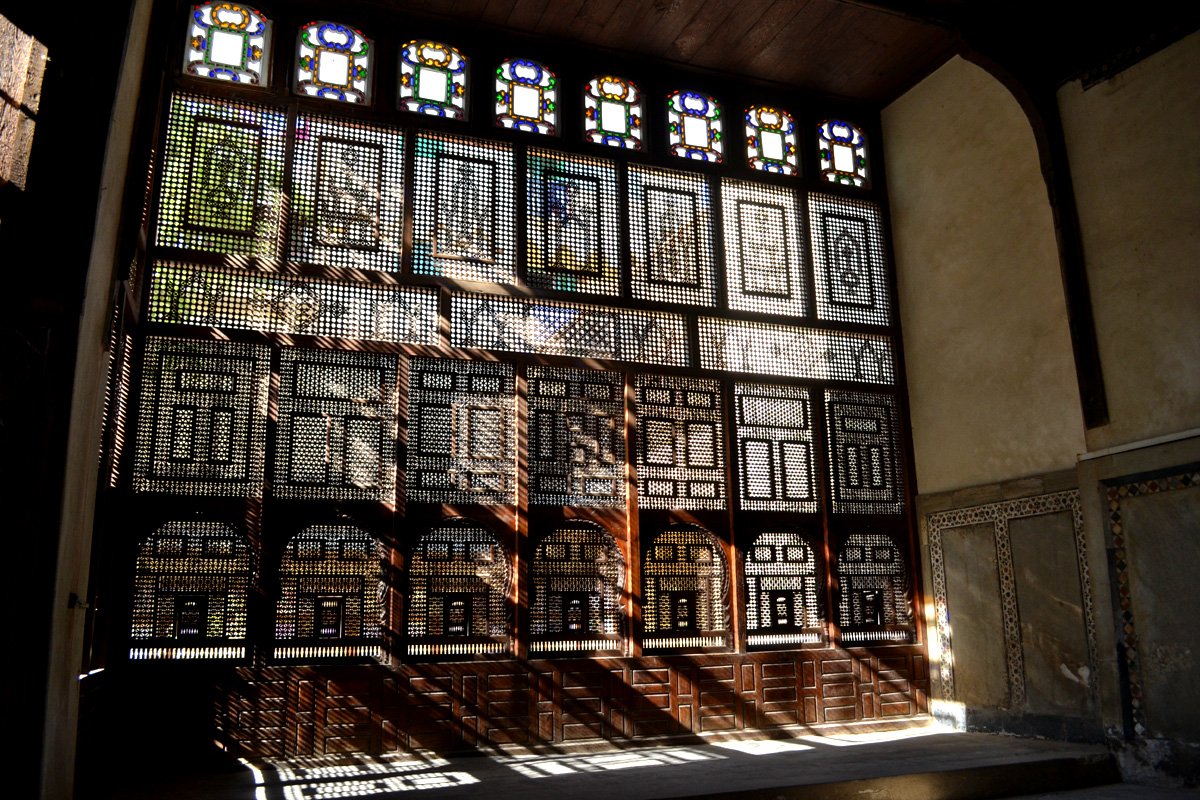
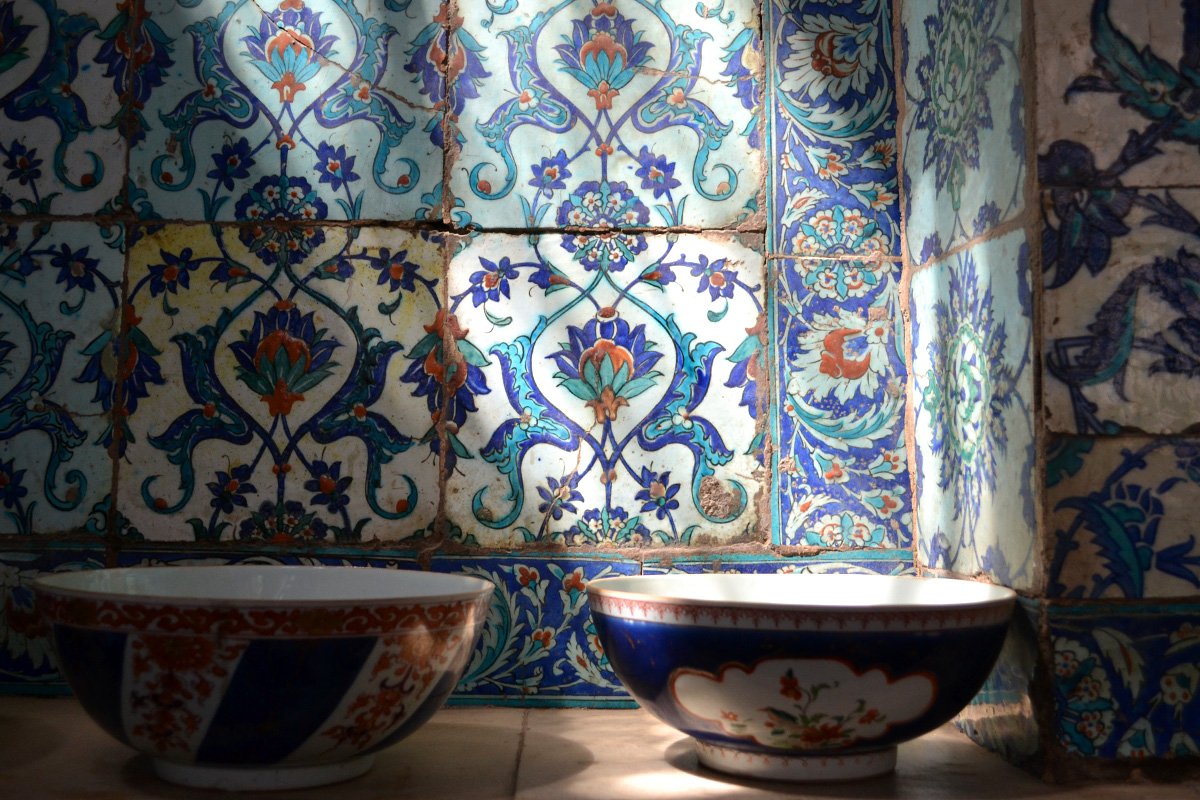
Bayt al-Suhaymi is a historic Ottoman-era home turned into a museum featuring mashrabiya windows, marble floors and period furniture. It offers a fascinating look at everyday life in 17th-century Cairo.
Nestled in a quiet alley just off Moez Street, Bayt al-Suhaymi has a breezy palm-lined courtyard from which you can admire all the fine mashrabiya.
Bayt al-Suhaymi is one of my favorite spots to experience the atmosphere of historic Cairo – and to take a break from sightseeing the district’s many mosques. It’s been lovingly restored and much of the wooden furniture and ceiling decor is still intact.
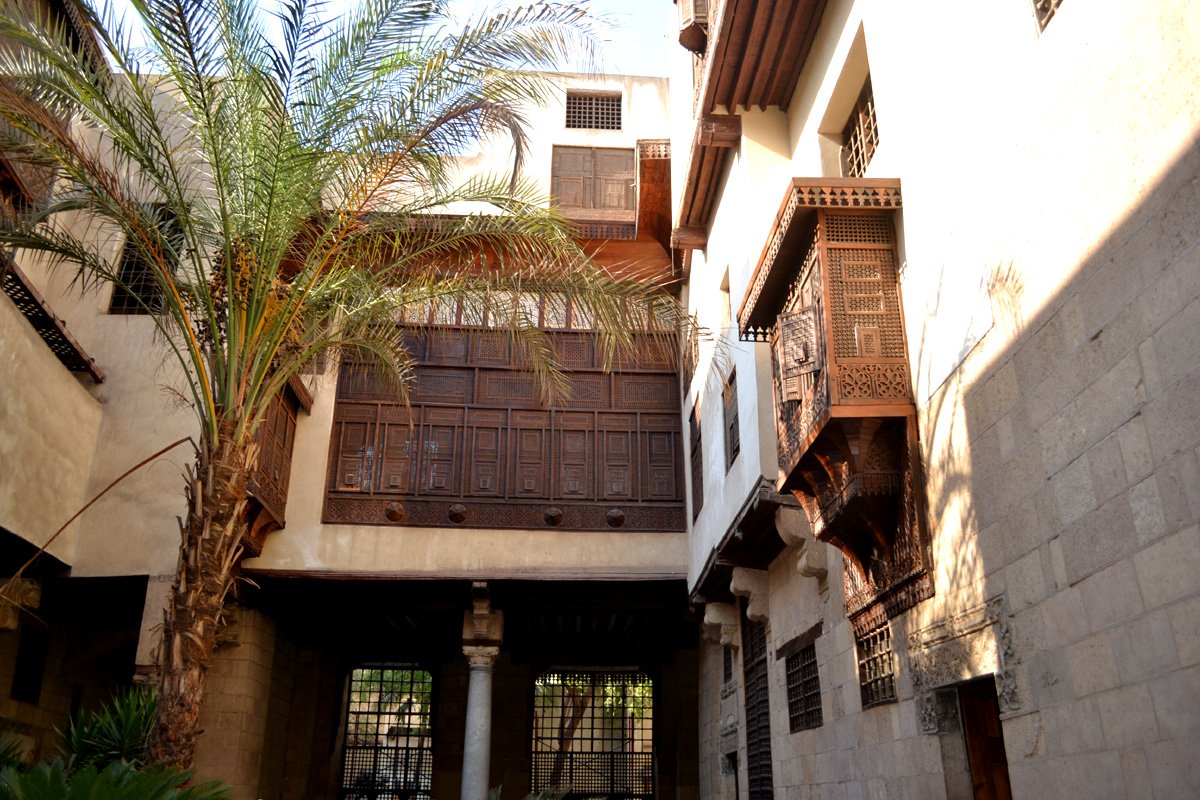
Don’t miss the haramlik section, the private spaces for women. The women enjoyed views of the house guests in the courtyard while being concealed behind wooden screens. There’s also a beautiful room full of blue tiles and lined with ornate ceramics.
Need to know:
Tickets: 80 EGP per adult and 40 EGP for students with valid ID.
Hours: Open daily from 9 am to 5 pm.
On Google Maps: 3726+RX
10. Hakim Mosque
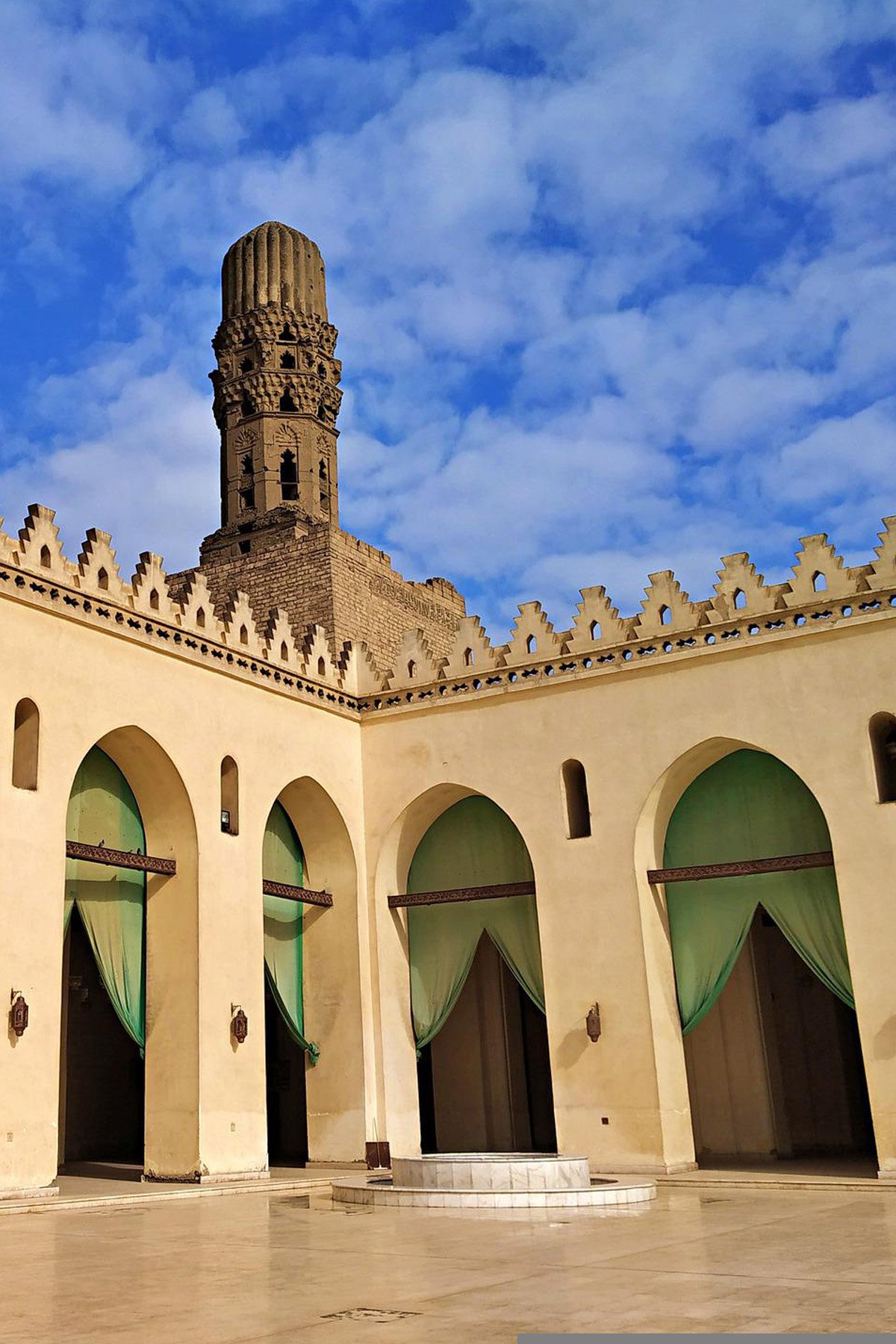
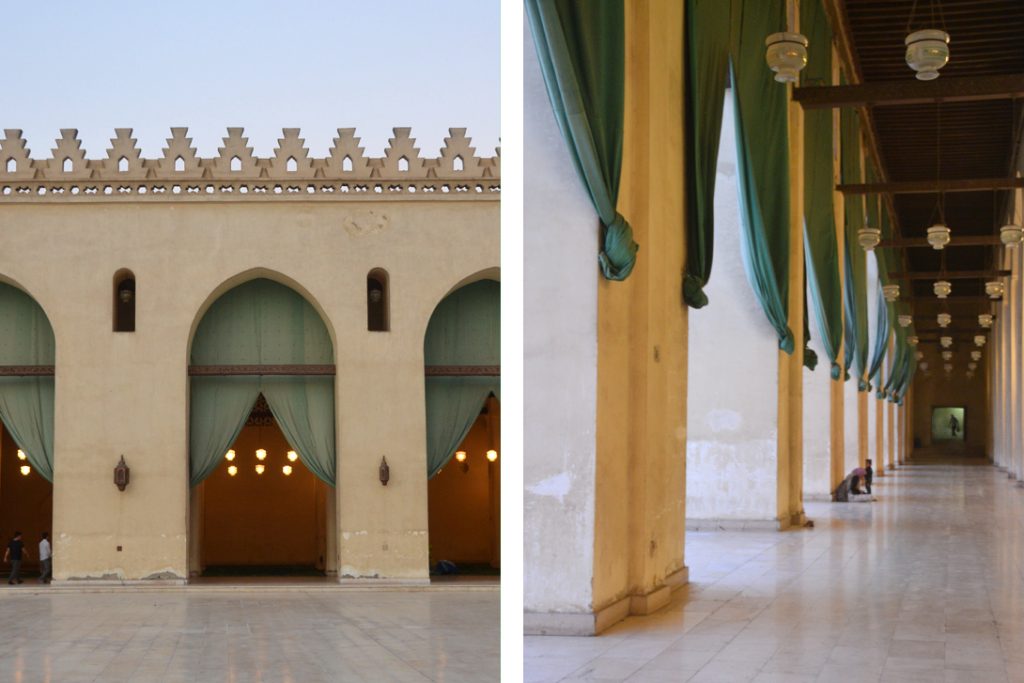
Built by a controversial caliph (who some consider insane), this 11th-century mosque has very unique minarets and a beautiful courtyard with flowing green curtains.
It’s also a great final stop for an Islamic Cairo walking tour – and denotes the end of the historic Moez Street. And it’s one of my favorite mosques in Cairo with its unique architecture and quiet atmosphere.
There are shady benches in front where you can rest under orange flowered trees and watch kids playing soccer under the mosque’s walls. It’s generally less crowded here than in central Khan el Khalili.
There are some small cafes if you want to take a breather. Bab Al-Futuh is also nearby – the northern gate that once sealed in the medieval city of Cairo.
Inside the mosque, there’s a rectangular open courtyard with parallel columns running on all sides draped with long and flowing green curtains. The unique minarets, built in the North African style of the Fatimids, are topped by a cylindrical body.
Historical facts:
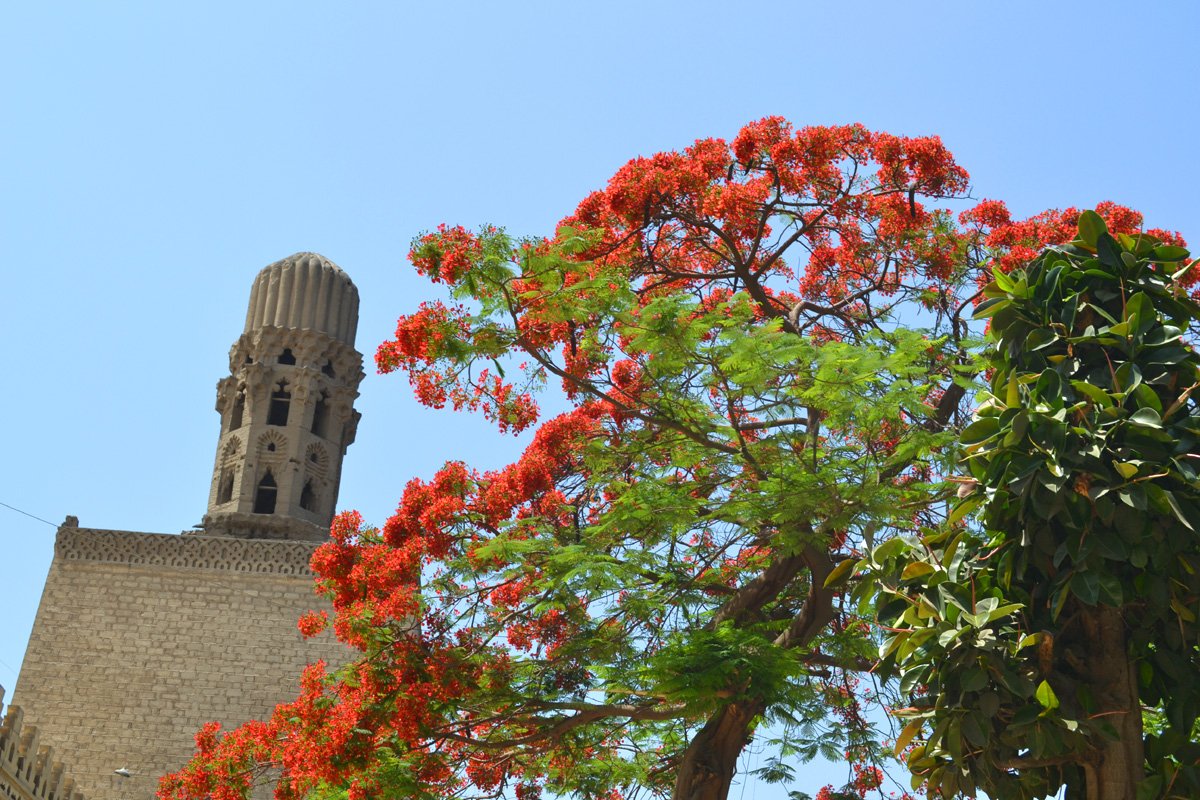
- Hakim Mosque was built in 992 by the Fatimid caliph Al-Hakim bi-Amr Allah, sometimes called the “mad caliph” for his cruelties and bizarre rulings. He once famously banned molokhia, a famous Egyptian dish, and forbade shoemakers from making footwear for women (since they should stay home).
- Through the centuries, the mosque was used as a prison for captured Crusaders, as a stable by Saladin, as a fortress by Napoleon (when the minarets were used as watchtowers), and as a local school.
- It’s been lovingly restored by the Indian Bohra Shiites (the Fatimids were Shia).
I usually end my day at Islamic Cairo with a stop at Hakim Mosque. Then I walk back to Azhar Mosque and take an Uber from there.
Need to know:
Tickets: Free.
On Google Maps: 3737+RC



